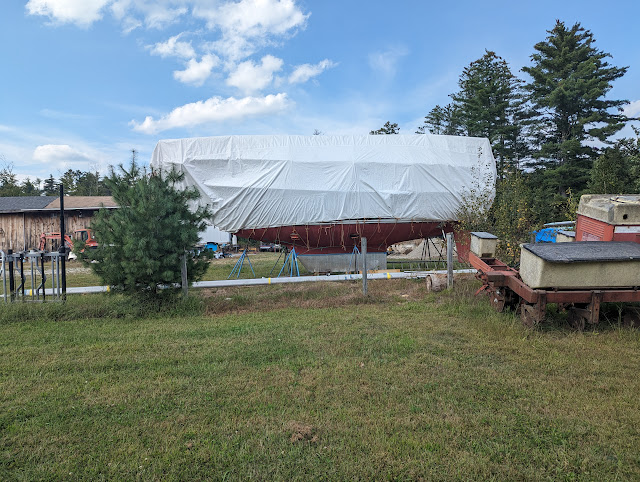I thought I would never utter the phrase: "I just bought a big boat" again, but apparently I'm a sucker for pretty boats (and punishment). I had sold my previous boat (an Alberg 35) after a 5 year rebuild followed by 3 years of trouble free sailing before I came to the realization that if my wife and I were to afford to help send our kids to college, something would have to go. Not having a big boat and all of the associated expenses would be a good place to start so I put Magic up for sale. I had always thought that maybe when I retired I would get another boat, but that all seemed very far off until earlier this summer.It started back in July while I was recovering from surgery and on short term disability. I was just sitting around and sick of watching Netflix so I decided I would pop onto Craigslist and see what boats were for sale (it's just something I do). As I was scrolling through the list of sailboats in NH, I came upon a somewhat vague ad describing a 1986 Niagara 35 for sale in Newington with a few small pictures that appeared to be stock photos. I don't remember the exact words, but it said something to the effect of: "looking for someone who can manage big projects". I had always liked the design and salty looks of the Niagara so I decided I would reply to the listing to get a little more information and see if it was still for sale just to satisfy my curiosity.
The seller quickly responded that yes, it was still for sale and told me the following story:
My friend, Steve, died on December 1st. Incredibly sad. He and I were sailing partners for decades. He left the boat for me. He was a talented engineer, and had designed and built (with help from me) a 30' steel cutter, inspired by the Cape Dory 30 design. He retired 7 or 8 years ago, and saw the Niagara 35 for sale in Annapolis, went down, liked it, bought it, and had it trucked to Great Bay Marine, up river from Portsmouth, NH. There she sits. He was in the midst of a refit when he got sick, and work stopped. All systems are out of the boat, including the engine. He had dropped the keel, installed new keel bolts, resealed the keel to the hull and she is whole again. He had purchased over $40k worth of equipment for the boat, all of which is at his wife's home in Kittery. I had the boat surveyed in March, and it was a good report.
The seller sent along the survey that had been completed in March of 2023 and went on to say that I was free to go take a look and see what I thought. Since I was just sitting around on disability with nothing to do, I decided to take a ride out to the seacoast and have a look. The survey hadn't turned up much to tell me to run away as fast as possible, but for the price he was asking, I figured it would be a total disaster anyway.
What I found was not what I expected. The boat was well covered and after shimmying onto the boat through the stern I was surprised to see that the boat was actually in decent condition and everything was dry despite being on the hard for about 10 years. All the systems except the electrical had been removed and there were brand new water, fuel, and waste tanks sitting on deck waiting to be installed. All the cabin flooring was up on deck revealing bilges that were sanded and ready for new paint. Another item of note was that the keel had been dropped and rebedded with GFlex epoxy along with new fasteners.
So the boat was not a dog at all and structurally it was in good condition, just waiting for someone to come along and re-install everything. I figured that this was the next insurmountable problem. Sure, I could purchase a solid hull, but if all the equipment is junk then what's the point. I don't think my wife would go for me spending a few years and $50k just to put the boat back together.
I was getting sucked in though, and I got in touch with the seller again and asked if I could take a look at the equipment. We arranged to meet a few days later and when he opened the garage door I couldn't believe what I saw. Piles and piles of new in box pumps, chartplotters, radar, anchors, rigging, etc.. The sails were used, but in great shape and had been professionally cleaned and serviced. The engine, a Westerbeke 27 was torn down, but the list of new OEM parts just for the engine added up to almost $8k.
At this point, I had entirely forgotten that I had no intention of owning a new boat and started working on the logistics side of making it happen. I won't go into details, but on August 27th I showed up to the seller's house in Maine with a 15 foot UHaul and a check. 2 hours later I was the proud owner of a huge pile of stuff. Oh, then there's the boat, but that comes later a bit later when the towing company could schedule a pickup.





















